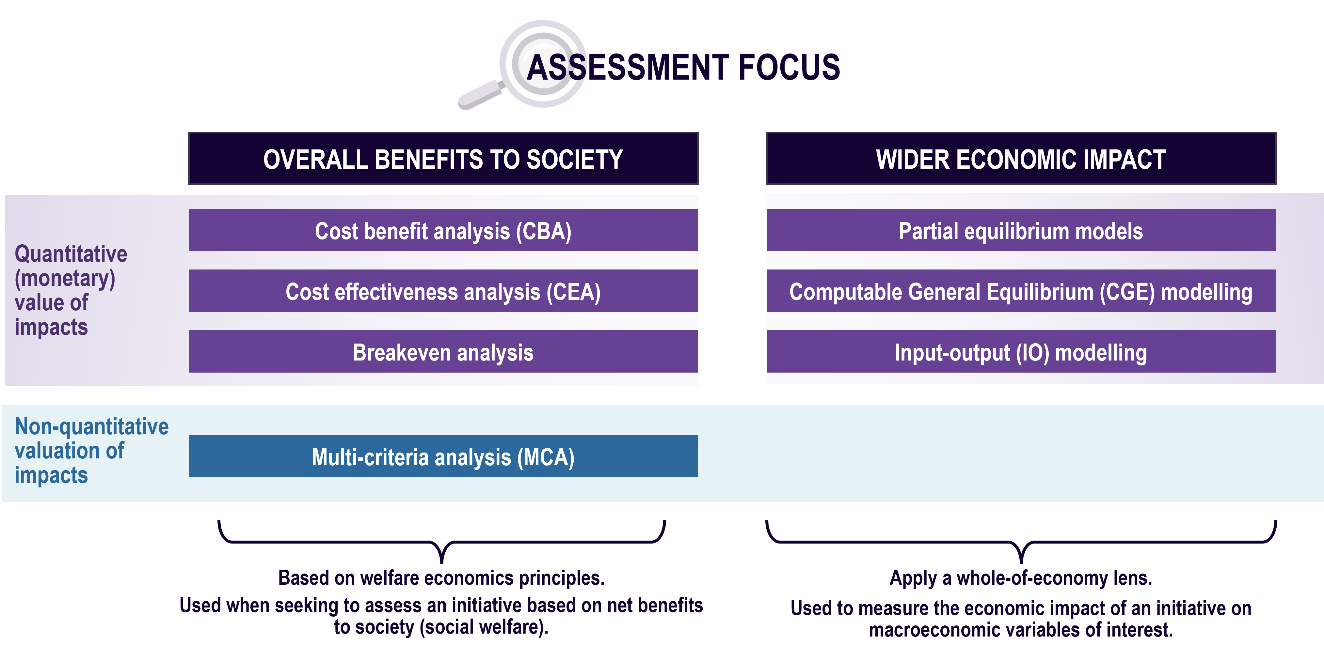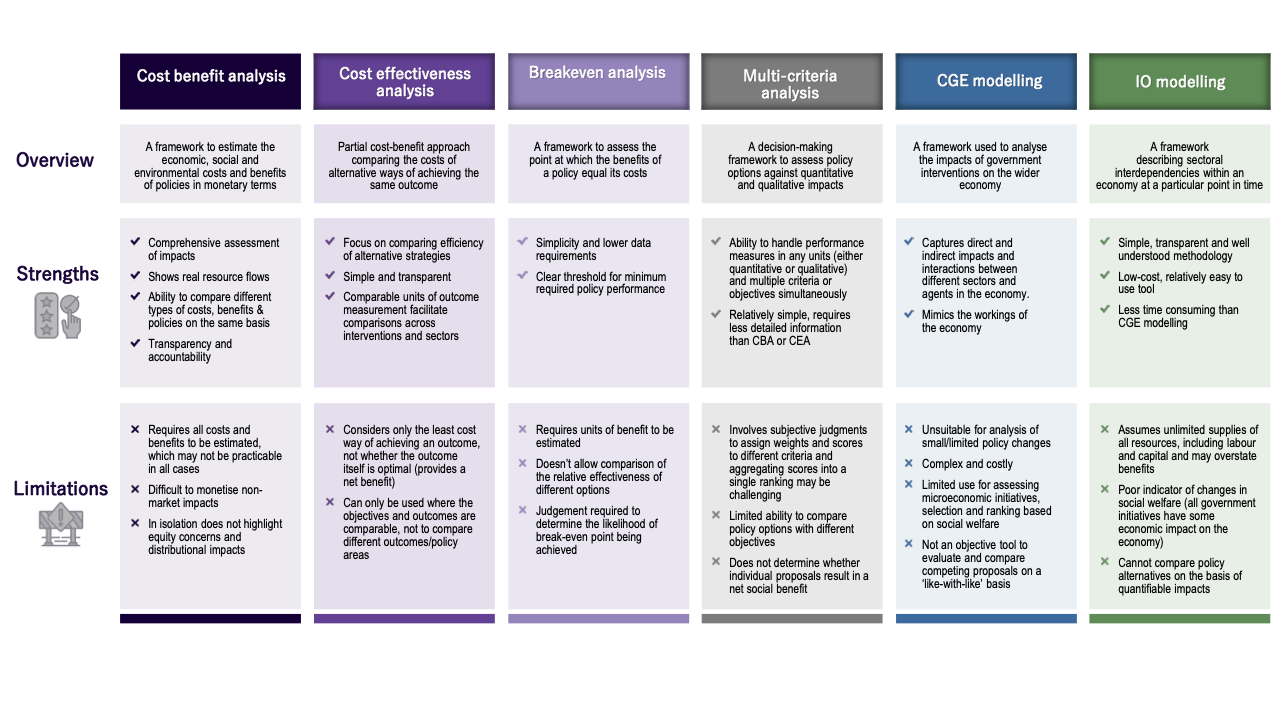Insights
The impact journey: selecting the right tool for economic impact analysis
03/09/2024
In an era where public funds and policy decisions are under increasing scrutiny, the demand for transparency, efficiency, and value in government spending has never been greater. Governments are under pressure to ensure that their policies and programs are effective and provide tangible benefits to the public. Economic impact analysis plays a crucial role in this process by determining whether these interventions offer the best value for money, and providing evidence of their impact on the Australian economy, environment, and society.
When it comes to regulation, economic impact analysis becomes even more critical, as it assists policymakers in determining whether an issue requires government interventions and if so, in understanding the potential costs and benefits of intervention on different sectors of the community. By doing so, it helps ensure that regulations are well-designed, well-targeted, and ultimately fit for purpose.
Every day, policymakers across Australia must weigh up different economic impact measurement methods to select the most appropriate tool(s) to:
generate insight into the design of policies and programs
measure progress towards achieving policy/program objectives
generate robust performance information that supports continuous improvement, risk management, accountability and decision-making at all policy stages1
meet a range of policy and legislative requirements – for instance, the Australian Government requires impact analysis for ‘Any policy proposal or action of government, with an expectation of compliance, that would result in a more than minor change in behaviour or impact for people, businesses or community organisations’2.
Choosing the right tool to measure economic impact can be a challenging process. With so many economic impact tools available, it’s not always easy to figure out which one—or which combination—will work best. The decision depends on what questions you’re trying to answer, how you plan to use the analysis, and the specific details of the intervention you’re looking at, among other things. Because there are so many methods available, people in government, public policy and industry often find it challenging to select the most appropriate approach and justify it.
No silver bullet, but appropriateness is an issue
It's generally accepted that there's no single "right" way to conduct an economic impact assessment. In fact, a variety of tools can be suitable under different circumstances. The best tool (or combination of tools) depends on several factors, such as:
the purpose and focus of the impact assessment (what questions you’re trying to answer)
the context and intended use (whether it's for advocacy, allocating funds, improving processes, or managing risks)
the nature of the intervention (its goals, stage of development, and how visible or measurable the impacts are)
the resources and limitations you have (like data availability, deadlines, and budget).
The idea behind this is that different methods come with their own strengths and weaknesses, so the choice depends on what's most appropriate for the specific case.
The menu of economic impact analysis tools
The most common tools for economic impact analysis are identified in Figure 13. Broadly, these tools can be broken down into 2 categories:
Tools that are based on welfare economics principles which aim to measure the overall benefits of a program or policy to society. These tools include Cost benefit analysis (CBA), Cost effectiveness analysis (CEA), breakeven analysis and Multi-criteria analysis (MCA).
Tools that apply a whole-of-economy lens to measure the wider economic impact of an initiative on macroeconomic variables of interest. These tools include partial equilibrium models, Computable General Equilibrium (CGE) modelling and Input-output (IO) modelling.
Figure 2 summarises the characteristics, strengths and weaknesses of these different tools in a “hands-on” way.
| Figure 1 Common tools of economic impact analysis |
 |
| Source: ACIL Allen |
| Figure 2 Characteristics of most common tools for economic impact assessment |
 |
| Source: ACIL Allen |
Choosing the most appropriate tool for economic impact assessment
Governments across Australia have created guides to help policymakers choose the best methods for assessing the economic impact of their policies and programs. While these guides are helpful, often it takes good judgement and experience to know which tools are most appropriate and can provide an assessment that is sound and transparent.
At ACIL Allen, we frequently collaborate with public sector agencies and private enterprises to help them choose the appropriate economic impact tools through guides, reports, and training. The goal of these partnerships isn’t necessarily to give a simple answer about the best tool to assess the impact of a particular policy or program, but rather to help policymakers refine, clarify, and articulate the choice of method in a logical and structured way.
The growing demand for transparency and accountability in government spending and decision making has underscored the importance of economic impact analysis. This process is critical for evaluating the effectiveness and value of policies and programs, ensuring that public funds are used efficiently to benefit society. The complexity of choosing the right economic impact measurement method or methods highlights that there is no one-size-fits-all solution. The tool or tools used depends on the specific context, objectives, and constraints of the intervention in question. By carefully selecting the most suitable tools, policymakers can generate robust insights that guide policy development, enhance accountability, and ultimately improve outcomes for the Australian economy, environment, and society.
Over the coming months, we will publish a series of articles that provide more details about each of these impact assessment methods and tools. These articles are intended to offer insights of the tools commonly used at ACIL Allen for impact assessment.
1 Australian Centre for Evaluation 2024, Commonwealth Evaluation Toolkit.
2 The Office of Impact Analysis 2023, Australian Government Guide to Policy Impact Analysis, p.8.
3 There are other economic tools and methods for specialist analyses which are less commonly used and are not included in this figure.

